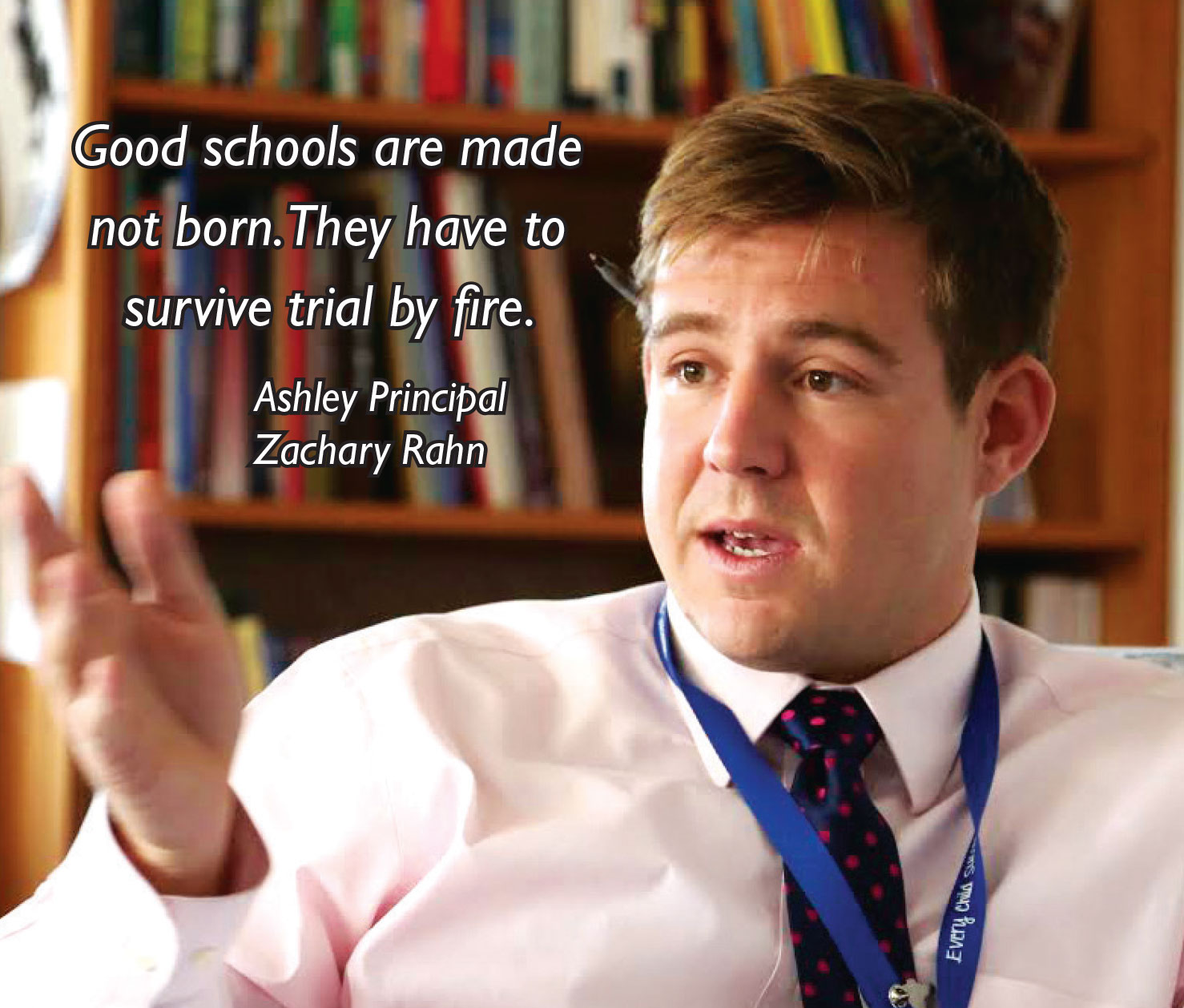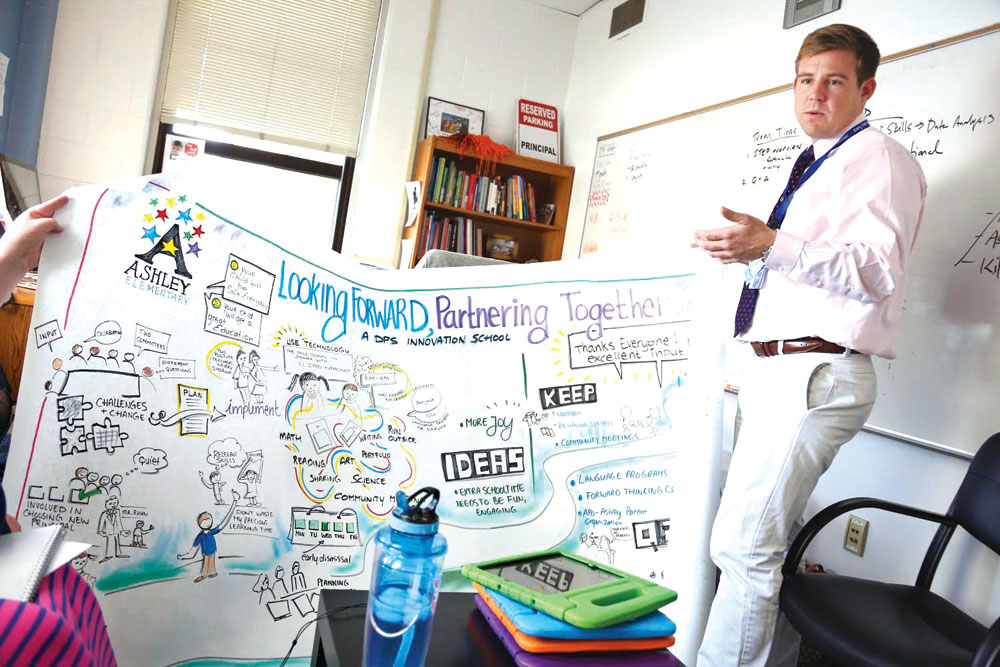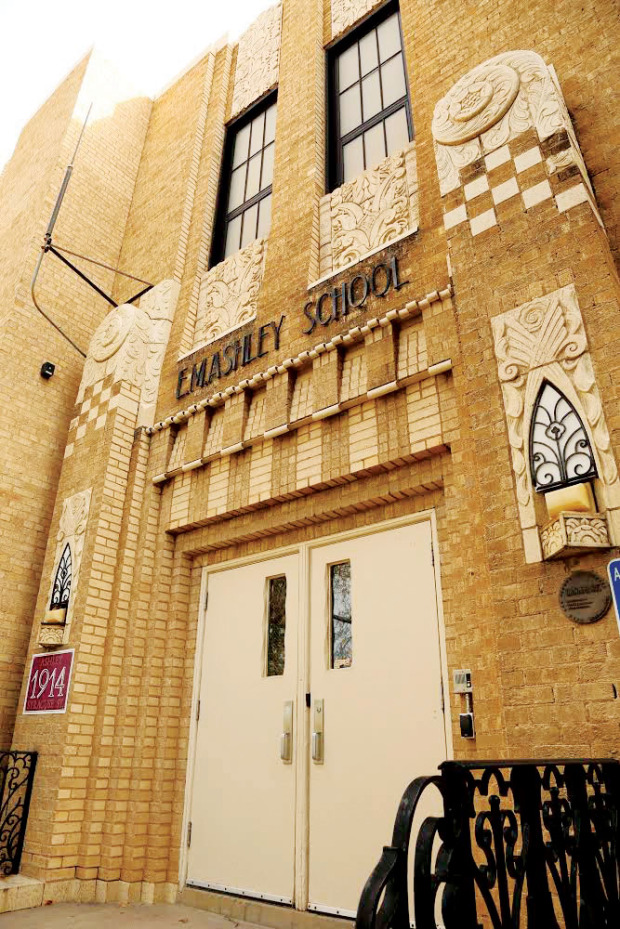
The painful and difficult, but ultimately hopeful, story of Ashley Elementary’s transformation
Turnaround. To many parents and teachers who have experienced it at their school, it’s a painful subject. Though a school may be considered “failing,” parents, teachers and staff are still investing themselves in their students’ education and taking pride in their efforts. When those people are told a new staff and new program are coming to their school, many respond with hurt and anger—feeling their efforts are being cast aside.
DPS made such an announcement at Ashley in April 2013 and the school community was shocked and angry. DPS listened to their concerns and came back soon thereafter to say the staff could stay and DPS would work with a committee (the Strategic School Design Team, including the principal, teachers and parents) through the summer to make a new plan to raise achievement and draw in more neighborhood children. (At the time, 33% of Ashley boundary students were opting out.) The old principal ended up leaving, and a new principal, Zachary Rahn, was selected by DPS and a committee from Ashley.

Ashley principal Zach Rahn shows the graphic image of what was discussed at a parents meeting last spring. Rahn plans to continue having such meetings to talk about vision, goals and challenges as the program evolves.
The plan continued to be refined after school started in 2013. That fall the teachers voted in favor of the new plan, including innovation status, which gave the school more autonomy in teacher hiring and evaluations, school calendar and curriculum among other areas.
Ashley Elementary is now 18 months out from the April 2013 meeting. Principal Zachary Rahn, in reflecting on the process, says, “You have to wonder, when you do turnaround…is it healthier or easier on a culture to say everyone’s going to leave and we’re going to start over? Or is it healthier to say we’re going to set the environment for you, build a plan and then if you want to opt out you can and if you want to stay you can too?” Rahn says. “I can see both perspectives. I have lived one but not the other. I do know where we are now is an incredible place for kids and adults to learn and the teachers who stayed are thriving.”
Rahn says he approached the transformation of Ashley and attracting families to the school with a business mentality. “We cannot expect that families are going to come,” he says. “We provide a service and if we don’t provide the service to meet their expectations, they have every right to be upset with us.” Part of that business mentality included thinking about the Ashley “brand.” “When you think about a brand of a store or product, you feel something,” says Rahn. “And when you thought of the Ashley brand, it was not a good feeling and we had to do something to convey to folks that it was a new chapter.”
Changing the perception of Ashley began with Rahn, teachers and parents reaching out to neighborhood families, going door-to-door, telling them about the plans for the school and inviting them in to visit. Enrollment decreased in 2013-14 during the transition, and was projected to stay low until the new plan proved itself. But the enrollment increased dramatically this fall, increasing by 30 students to 365. If the increasing enrollment continues, the school will soon reach its capacity of 400 students.

Ashley Elementary, one of Denver’s schools with beautiful classic architecture, is located at Syracuse St. and Montview Blvd.
The new plan included creating a school culture of high expectations, a rigorous academic program, two teachers per classroom (a lead and an associate), blocks of instruction time, an extended day (from 8am-4pm with the last hour for enrichment including sports and music); and the introduction of technology into the classroom (which extends to home learning—see iPad story on page 1). Ashley also implemented weekly teacher evaluations and has numerous committees with strong parental involvement.
However, a dramatic change doesn’t come easily, and the 2013-14 transition year was an emotion-filled time. “You rip the Band-Aid off because we know when you make gradual change, you fail,” says Rahn. “There’s never been a turnaround school that has been successful that gradually makes changes.”
In the spring teachers had to finalize their decision on committing to the many changes required by the new plan. Of the 21 licensed teachers who were at Ashley in 2013-2014, Rahn says 11 of 21 teachers stayed under the new program. One retired, two were reduced because of enrollment projections, two were non-renewed at Ashley due to performance, two moved out of state, two moved on due to not being a program match, and two positions were reduced due to not being in the innovation plan.
When parents realized how many staff were departing, emotions again rose to the surface. The school held a “Vision Casting” where parents could talk about the changes and share their ideas for what they wanted in the school, paths to accomplish that and the challenges they faced. A graphic designer visually illustrated what was discussed (the graphic representation of that meeting is shown on page 10.) “The theme was how we can partner together to create the school we want,” says Rahn, who plans to hold another session this year. “We’re engaging in conversation and it shows that change is really, really hard—more so for adults than kids.”
Donna Sims, grandmother of three Ashley students in grades kindergarten, 2 and 4, and a fourth who graduated from Ashley last year, was at first unsure about the changes. After learning more, she felt better and advised Ashley parents (and would advise others going through a turnaround) to attend meetings to better understand the changes. “Don’t be so resistant,” she suggests. “That’s how I was in the beginning but I asked questions and understood how it could be good.” Sims became part of the committees and says, “I liked the way the old staff worked together but now we have a staff that has agreed to put that vigorous time and effort in to meet that achievement level that we want our students to have.”
Mother of third grader Miguel Rivas, Martha Martinez says she wanted to keep her son at Ashley to experience how good the changes could be. She has seen improvements in her son since last year including better behavior and improved responsibility.
Phil Garvin, President of Colorado Studios (among many other business accomplishments), has an office just down the street from Ashley and for years has been a staunch supporter of the school, donating both his time and money very generously, including serving as president of the School Collaborative Committee in past years. His observations of the turnaround: “The parents and students overwhelmingly loved the teachers,” and he questions whether the high turnover of staff was good for the school. And he thinks the teachers didn’t really understand what they were agreeing to when they voted for the plan.
But Rahn and his boss Alyssa Whitehead Bust, head of academics and innovation at DPS believe the teachers, to their credit, were voting for what they believed was best for the kids and the school, even if it wasn’t a perfect match for them personally. Whitehead Bust pointed out that so many aspects of the school are fundamentally different, “it doesn’t surprise me that some folks would find that those aren’t the right matches for them. I know that startup is such an intense period that it can create this incredible energy but you can also create a real sense of exhaustion, so you have to wonder how much of that played out as well.”
Jessica Langford, a kindergarten teacher, who moved from Florida to be part of the new Ashley after hearing the buzz about it in the academic world says, “It’s challenging. We’re transforming education right here, right now. We all put in copious hours of additional work at night and on the weekends. And for some, professionally, I don’t think that’s where they saw their future.”
The teachers consider last year “year 0” and this year “year 1” for Ashley. “Last year was awful,” says Michael Cammilleri, who teaches ECE and is responsible for Student Community Engagement (aka Dean of Fun) and is the Blended Learning Coach. He is in his 6th year at Ashley and had been pushing for changes in the school for years. Cammilleri, who served on the Strategic School Design team, says the atmosphere was very negative between the teachers who knew they weren’t going to stay and those who wanted to stay and be part of the turnaround. “Lots of people…had only worked at Ashley so when you bring in a new model, a new regime, it’s really easy to blame that new structure. The community feel was pretty ugly for the majority of last year.”
“These are people we still know and still see and it’s hard not to sympathize with that,” Camilleri adds. “When they’re going through this awful period in their lives, when they’re breaking with something they’ve been with for 5, 6, 10 years, it puts you in a really difficult spot because you’re trying to hold true to the new administration and hold true to these relationships and friendships you’ve had for years.”
Mathis Santella, fourth grade teacher, adds, “But at the same time, it was made clear that if this isn’t for you, administration would do what they could to help you land on your feet somewhere else.” He adds, “The adult culture last year was terrible because of what was happening. This year, I can say the adult culture is awesome. I mean just the energy, you can feel people are invested and on board.”
Cammilleri agrees. “We had a new administrative team and they were subjected to people who were not ready for the change they got. Now that we’ve assembled the people who are ready to make it happen, it’s not figuring out who can do this or who even wants to do this. It’s more of how are we going to do this together now.” He adds, “These people are ready for something new, to put in the work.” Ann Flanagan, P.E. teacher, adds “They (new teachers) were given the expectations ahead of time before they ever signed their contract. They knew what the plan was so it wasn’t a surprise. They chose it.”
Rahn wasn’t surprised that the turnaround for Ashley has been difficult. He cites research done on highly successful organizations showing that when a change process occurs, certain steps inevitably follow: an initial honeymoon phase of being excited about something new; “storming,” in which things become tumultuous; “norming,” when things start to work; and “performing,” when things are going really well. Rahn says Ashley went through that process “to a T” last year and he talked openly about the journey. Mid-year, after systems and structures in the building had been in place for a while, Rahn put a timeline on the wall, listing key events such as the first day teachers came to work, the first day of school and the days they implemented new structures in the school. Then, Rahn listed how he felt at each of those times. For instance, on the first day of school, Rahn overheard someone saying they weren’t sure the new school plan was going to work. He put that he felt “defeated” on that first day and noted his feelings at each of the key events.
After the staff added their feelings, Rahn pointed out that they had, indeed, gone through the steps from being excited about the school, to being unsure, to staff members bickering over methods, to seeing that it was working and improving. “We realized it was normal to feel this way, to have gone through this really hard process and that the kids are better off today than when we started. That feeling was unanimous across the school,” says Rahn.
Rahn says the next steps will focus on sustainability, looking several years into the future for plans and funding. Rahn feels the idea is to “create the environment for rapid change and then have the perseverance to hold steadfast through that grueling change process,” adding, “I think the next two years in DPS will be really interesting. I think we’ll see more examples of success and more change that we know works. I feel like it’s getting better.”




My name is Shane Nelson.
First off, I want to Commend The Front Porch for its article on Ashley Middle School.
I am an educational consultant and have been hired by some of the highest and lowest performing schools in California. From Compton and South Central, to Beverley Hills and the Private School sector, I have seen countless models and practices.I evaluate, create content and develop programs that help students, staff and schools reach their potential in education. !
The three factors that are always obvious are: Resources, Staff/Facility and Educational Environment (Safety). The truth is, well funded schools attract high achieving students, families and administrators. That in turn draws more funding. Thus, giving these schools a surplus of resources to achieve their goals.
Underfunded schools have a much more dynamic population of students and families. They are often dealing with a larger group of students that qualify for Special Education, students new to the country and families that are having their own struggles.
This reflects on the Standardized Test Scores which are the main basis for school assessment. The results are lower scores, not based on the potential, competence or commitment of students, parents and staff, but as a result of a much more difficult, and often unrealistic process of education.
I recently had the honor of visiting Ashley Elementary. I was moved to a point of almost tears when I saw what was happening there. Students are not called students, they are addressed as “Scholars”. Each and every one is greeted at the door with a “Good Morning” and a handshake form a staff member. The dedication and cohesiveness of the teachers and administration is better than at any school I have ever seen. Ego is cast aside, the mission is agreed upon and committed to by one and all. The student to teacher ratio is ideal for the staff and the student alike. The line up of parents personally walking their children into the school was beautiful.
Technology is placed directly into students hands which will allow them to be relevant and ready for the modern world (this is a massively important resource lacking in so many schools where funding is low). They practice and provide a “school culture” that is 100% built around not only education, but relationship building. The latter, is a life skill often overlooked by even the most prestigious schools. Students who behave in a way that would normally warrant detention are give “Reflection” instead. This removes punishment and provides both enrichment and the opportunity to “self-correct”. Everyone of us, both as children and adults would flourish in an environment like the one being created at Ashley.
The time, dedication, competence and sense of duty I witnessed, from the principals to the teachers, the support staff and even the janitor I conversed with, gave me a feeling of not only hope, but a revived inspiration that this kind of work not only can, but IS being done.
The last aspect I want to address is SAFETY. There is no way a child can reach their potential in an environment that is unsafe. From the minute I stepped onto the campus I felt not only protected, but that I was truly standing on ground where rights are respected, human beings are valued and education is mandatory. This is a place where people go to learn.
They are doing something bold and brave over there on Syracuse Street. Yes, there have been growing pains, yes there has been controversy, but those are the costs of courage. Never be- fore has the term “Turn Around” been more applicable and warranted.
I assure you, what they are doing is worthy of national recognition and replication. They need your support, your questions and your courage to see this through. I highly suggest you give it to them.
Thank you Ashley, and The Front Porch for the glowing example that not circumstance, condi- tion or crisis is to big to be overcome.
“Ships are safe in port…..but that is not what ships are for”.
Shane Nelson